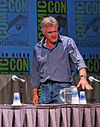User:Abyssal/Portal:Jurassic
Introduction
The Jurassic (/dʒʊˈræsɪk/ juurr-ASS-ik) is a geologic period and stratigraphic system that spanned from the end of the Triassic Period 201.4 million years ago (Mya) to the beginning of the Cretaceous Period, approximately 145 Mya. The Jurassic constitutes the middle period of the Mesozoic Era and is named after the Jura Mountains, where limestone strata from the period were first identified.
The start of the Jurassic was marked by the major Triassic–Jurassic extinction event, associated with the eruption of the Central Atlantic Magmatic Province (CAMP). The beginning of the Toarcian Stage started around 183 million years ago and is marked by the Toarcian Oceanic Anoxic Event, a global episode of oceanic anoxia, ocean acidification, and elevated global temperatures associated with extinctions, likely caused by the eruption of the Karoo-Ferrar large igneous provinces. The end of the Jurassic, however, has no clear, definitive boundary with the Cretaceous and is the only boundary between geological periods to remain formally undefined. By the beginning of the Jurassic, the supercontinent Pangaea had begun rifting into two landmasses: Laurasia to the north and Gondwana to the south. The climate of the Jurassic was warmer than the present, and there were no ice caps. Forests grew close to the poles, with large arid expanses in the lower latitudes. (Full article...) (Full article...) Selected article on the Jurassic world and its legacies
Insects are a class of invertebrates within the arthropod phylum that have a chitinous exoskeleton, a three-part body (head, thorax and abdomen), three pairs of jointed legs, compound eyes and one pair of antennae. They are among the most diverse groups of animals on the planet, including more than a million described species and representing more than half of all known living organisms. Insects may be found in nearly all environments, although only a small number of species reside in the oceans.
The life cycles of insects vary but most insects hatch from eggs. Insect growth is constrained by the inelastic exoskeleton and development involves a series of molts. The immature stages can differ from the adults in structure, habit and habitat. Insects that undergoincomplete metamorphosis lack a pupal stage and adults develop through a series of nymphal stages. Fossilized insects of enormous size have been found from the Paleozoic Era, including giant dragonflies with wingspans of 55 to 70 cm (22–28 in). The most diverse insect groups appear to have coevolved with flowering plants. Adult insects typically move about by walking, flying, or sometimes swimming. Insects are the only invertebrates to have evolved flight. Many insects spend at least part of their lives under water, with larval adaptations that include gills, and some adult insects are aquatic and have adaptations for swimming. Insects are mostly solitary, but some, such as certain bees, ants and termites, are social and live in large, well-organized colonies. (see more...) Selected article on the Jurassic in human science, culture and economics
Jurassic Park III is a 2001 American science fiction adventure monster film. It is the third installment in the Jurassic Park franchise and a sequel to the 1997 film The Lost World: Jurassic Park. It is the series' first film that was not directed by Steven Spielberg nor based on a book by Michael Crichton (though numerous scenes in the film were ultimately taken from Crichton's novels Jurassic Park and The Lost World). The film takes place on Isla Sorna, off Central America's Pacific coast, the island featured in the second film, where a divorced couple has tricked Dr. Alan Grant into going in order to help them find their son.
After the success of Spielberg's Jurassic Park, Joe Johnston expressed interest in directing a sequel, a film adaptation of The Lost World. Spielberg instead gave Johnston permission to direct the third film in the series, if there were to be one. Production of Jurassic Park III began on August 30, 2000. Upon its release, the film received mixed reviews, with many praising the visual effects and action scenes but finding the plot clichéd and unoriginal. Despite being less well-received than the previous films, Jurassic Park III was a box office success, grossing $368 million worldwide. (see more...) Selected image
Did you know?
Need help?Do you have a question about Abyssal/Portal:Jurassic that you can't find the answer to? Consider asking it at the Wikipedia reference desk. GeochronologyEpochs - Early Jurassic - Middle Jurassic - Late Jurassic Landmasses - Baltica - Gondwana - Laurentia - Siberia Fossil sites - Beecher's Trilobite Bed - Walcott–Rust quarry Researchers - Charles Emerson Beecher - Charles Lapworth - Charles Doolittle Walcott Quality ContentFeatured Mesozoic articles - Bone Sharps, Cowboys, and Thunder Lizards - Bone Wars - Edward Drinker Cope - Geology of the Capitol Reef area - Geology of the Death Valley area -Geology of the Grand Canyon area - Geology of the Zion and Kolob canyons area Good Mesozoic articles - Chitinozoan - Coal ball - Dimetrodon - History of paleontology - Evolutionary history of life - Ornatifilum - Opabinia - Paleontology- Schinderhannes - Small shelly fauna - Temnospondyli - Tiktaalik - Waptia SubcategoriesRelated contentAssociated WikimediaThe following Wikimedia Foundation sister projects provide more on this subject:
|





















